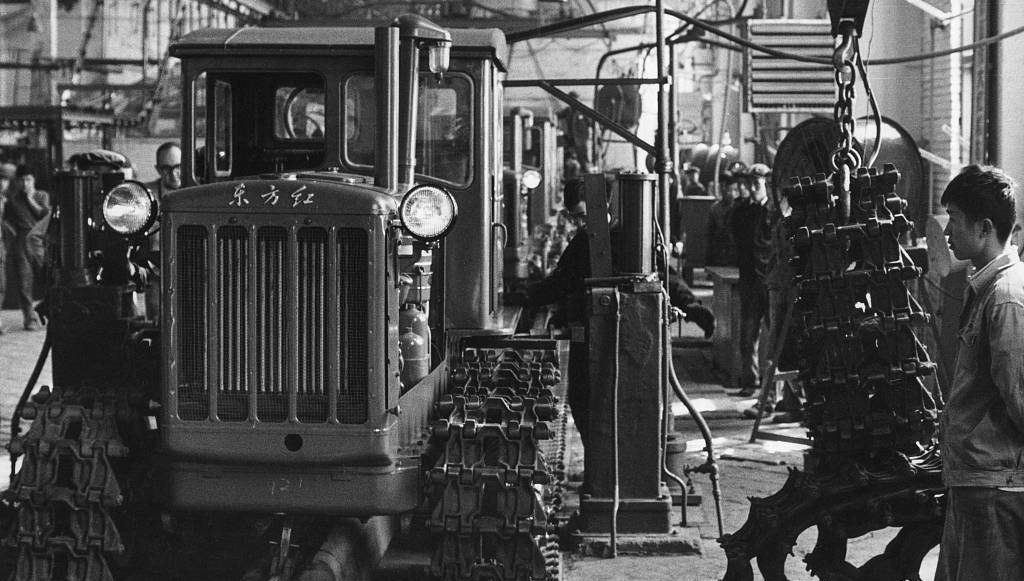China’s industrial revolution: A new perspective

To explain the Industrial Revolution in general (or the lack of one in some countries) and the rise of China in particular (or the persistent poverty in Egypt and India), one must first explain the emergence of the mass market itself in the 18th century England or 20th century China.
In this article, I will take the stand that the so-called “market” is a fundamental public good that provides the platform for commerce and trade to take place. This platform evolves in distinct stages and has three pillars to support it: political stability, social trust, and infrastructure. As I point out in my recent book (Wen, 2016), “The ‘free’ market is not free. It is a fundamental public good that is extremely costly to create.”
Therefore, the lack of industrialization in any nation seems on the surface to be due to the lack of mass production or mass supply (as Coase and Wang pointed out in their article), but is in fact due to the lack of a mass market, which in turn is due to the lack of market creators, as we will see below.
Clearly, since the mass market is a public good to support mass production, the state is then one of the most critical creators of the mass market. That is, creating a market requires state capacity and appropriate industrial policies.
The government sets the stage (platform) so that actors (firms) can play. Industrial policies are crucial because the mass market has internal spatial-temporal structures. Hence, creating a mass market is like synthesizing a high-dimensional chemical compound; it requires not only key ingredients but also correct steps or the right procedure. As I point out in my book (Wen, 2016),“The market for mass-produced industrial goods cannot be created by a single ‘big push’ either under full-fledged import substitution industrialization (ISI) or under ‘shock therapy.’ It can only be created step by step in the correct order (sequence). China’s rise to global economic supremacy has been unstoppable because it has found and followed the correct recipe (sequence) of market creation.”
Industrialization is a lengthy process that unfolds sequentially in history. It can be divided into several key stages: (i) proto-industrialization; (ii) first industrial revolution; (iii) second industrial revolution, and (iv) the welfare stage based on an affluent society that can mass produce everything. Each stage requires its corresponding platform and associated social-political-economic infrastructure for larger and more sophisticated firms and industrial clusters to emerge.
More specifically, proto-industrialization features massive numbers of workshops in rural or urban areas with small-scale production of basic consumer goods for long-distance trade; the first industrial revolution features mass production of labor-intensive light consumer goods for domestic and international markets, based on the large-scale factory system; and the second industrial revolution features mass production of the means of mass production, especially of capital-intensive heavy industial goods such as machinery, equipment,energy, and infrastructure.
The first stage is very primitive but extremely important, yet it has been largely ignored by development economic theories and theorists. During this primitive, initial stage, rural farmers or poor households in urban areas use their spare time to manufacture simple products to engage in long-distance trade. This primitive concentration and specialization of idle labor raises incomes and nurtures the formation of an increasingly unified market with primitive production networks while also developing industrious spirits and labor skills.
During the second stage, large-scale factory systems become prevalent in light industries such as textiles, processed food, toys, and furniture. This mass-production stageis labor intensive and export oriented, which benefits from poor countries’ comparative advantage in organized cheap labor. Mass production in this stage is profitable only because proto-industrialization in the initial stage created a large enough market and distribution networks for light consumer goods as well as the associated income level or purchasing power.
Finally, the expansion of light industries and distribution networks in the second stage facilitates the formation of more sophisticated and large market demand for heavy industrial goods such as trucks, automobiles, highways, railroads, coal, steel, metals, electricity, power plants, machinery, refined oil, chemicals, and all sorts of heavy equipment. This occurs not only because the income of workers becomes high enough to purchase big-ticket items such as automobiles, but also because mass production of heavy industrial goods is profitable only after light industries and their associated supply chains and distribution networks create a mass demand for machinery, advanced transportation, and other heavy industrial goods. In other words, heavy industrial goods are capital intensive and must also be mass produced on a large scale to be profitable, which requires a market that is far more massive, far more sophisticated, and far more unified than the mass market for light consumer goods.
The essence of this sequential developmental process is to gradually deepen and expand the size of the market to support the mass production of more and more sophisticated and capital-intensive industrial goods and thus fully exploit the economies of scale. This sequential process overcomes the problems associated with technology barriers and the lack of skilled workers and savings and organizational capital encountered by many developing countries at various developmental stages. Through this developmental process, the industrial structure and networks becomes more and more specialized, roundabout, and capital intensive.
(For the full article please check: https://www.sciencedirect.com/science/article/abs/pii/S1043951X21000894?via%3Dihub )
Editor: Leo Cai
Acemoglu, D., & Robinson, J. (2012).Why nations fail:The origins of power, prosperity,and poverty.New York:Crown Business.
Allen,R.C. (2009).The British industrial revolution in global perspective.Cambridge:Cambridge University Press.
Beckert, S. (2014). Empire of cotton:A global history.Knopf.
Chang, H.-J.(2003).Kicking away the ladder: Development strategies in historical perspective.London:Anthem Press.
Coase, R. H., & Wang, N. (2011). The industrial structure of production: A research agenda for innovation in an entrepreneurial economy.Entrepreneurship Research Journal,1(2).
Coase, R. H. (November 1937). The nature of thefirm.Economica,4(16),386-405.
Deane,P. M.(1979).The first industrial revolution.Cambridge University Press.
Landes, D.S.(1999).The wealth and poverty of nations: Why some are so rich and some so poor. New York: W. W. Norton & Company.
Li,X., Liu, X., & Wang,Y.(2014).A Model of China's State Capitalism.Unpublished Working Paper, Hong Kong University of Science and Technology.
Lin,J. Y. (2009).Economic development and transition:Thought,strategy,and viability.Cambridge University Press.
Lin,J.Y.(2011).Demystifying the Chinese economy. Cambridge University Press.
Lin, J. Y.(2012).New structural economics: A framework for rethinking development and policy.World Bank Publications.
Lin, J.Y. (2013).The quest for prosperity: How developing economies can take off.Princeton University Press.Long, C., & Xiaobo, Z. (2012). Patterns of China's industrialization: Concentration, specialization, and clustering. China Economic Review,23(3),593-612.
Long, C.,& Zhang, X.(2011).Cluster-based industrialization in financing and performance. Journal of International Economics, 84(1),112-123.
Mendels, F.F. (March 1972).Proto-industrialization: The first phase of the industrialization process. The Journal of Economic History, 32(1),241-261.
Mendels, F.F. (1981). Industrialization and population pressure in eighteenth-century flanders.New York:Arno Press.
North, D. (1981).Structure and change in economic history.New York:W.W.Norton.
North, D. C., & Thomas, R. P. (1973).The rise of the western world: A new economic history.New York:Cambridge University Press.
Ogilvie, S., & Markus, C. (1996). European proto-industrialization: An introdctory handbook.Cambridge University Press.O'brien, P., Griffiths, T., & Hunt, P. (1991). Political components of the industrial revolution: Parliament and the English cotton textile industry, 1660-17741.The Economic History Review, 44(3), 395-423.
Pomeranz, K. (2001).The great divergence:China,Europe, and the making of the modern world economy.Princeton University Press.
Qiu,L. D. (2005).China's Textile and Clothing Industry. Mimeo.Hong Kong University of Science and Technology.
Roll,E. (1968).An early experiment in industrial organization:Being a history of the firm of Boulton'Watt,1775-1805.Frank Cass and Company.
Rostow,W.W. (1960).The stages of economic growth:A non-communist manifesto.Cambridge University Press.
Smith,A.(2010).The wealth of nations:An inquiry into the nature and causes of the wealth of nations. Harriman House Limited (Original work published 1776.).
Wen, Y. (2016).Making of an economic superpower: The unlocking China's secret of rapid industrialization.World Scientific.
Wrigley, E.A. (2010).Energy and the English Industrial Revolution.Cambridge University Press.
Wu,J.(2005).Understandig and interpreting Chinese economic reform.Texere.
Zhang,X., Yang, J., & Thomas, R. (2017).Mechanization outsourcing clusters and division of labor in Chinese agriculture.China Economic Review,43,184-195.Zhang,Y.,& Zhang, S.-s. (2001).A short history of China's village enterprises(In Chinese:张毅、张颂颂编著,《中国乡镇企业简史》,中国农业出版社,2001).



